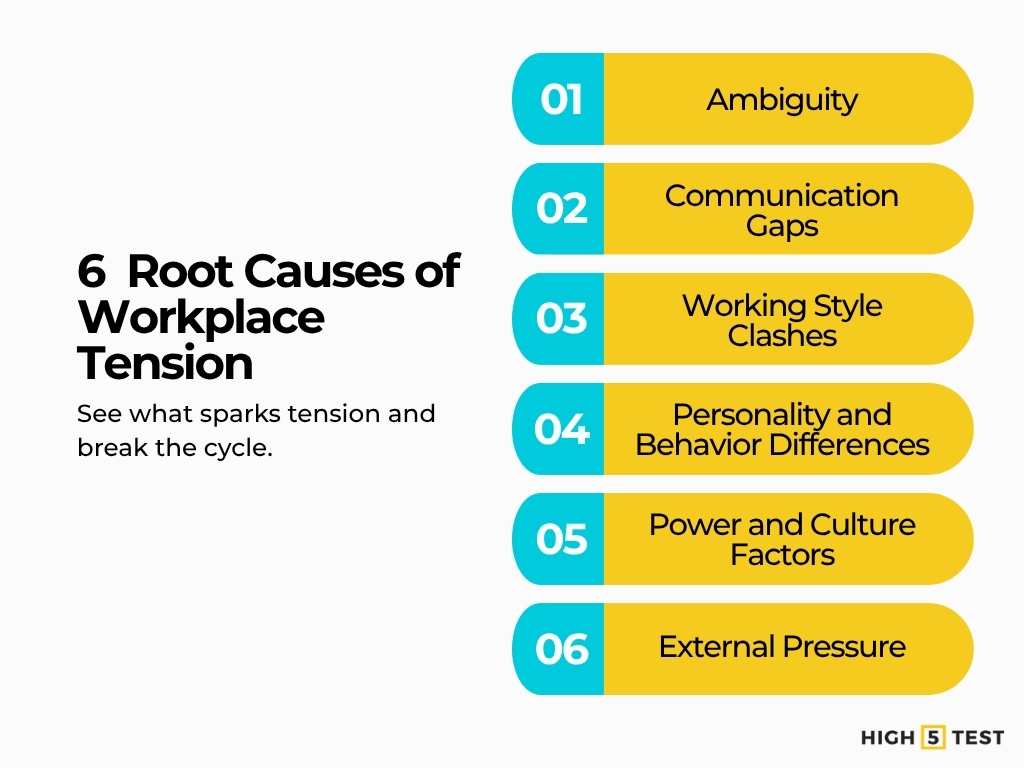Conflict at work doesn’t always make the headlines, but its effects are felt. Tension builds, engagement drops, time is lost, and employees may leave. Ideally, teams would collaborate harmoniously. In reality, disagreements arise from differences over tasks, personalities, and values. How leaders respond makes the difference.
In this post, I’ll walk you through how to see and stop those common conflicts early. You’ll learn how conflict arises, what to watch for, and how to apply solutions, including using the HIGH5 personality test for teams to build healthier dynamics over time.

What does “workplace conflict” look like?
Before solving a conflict, you have to recognize it.
Imagine a marketing team preparing a product launch. One person insists on extensive testing and multiple revisions; another pushes to go live quickly to capitalize on a trend. Another pair disagrees not on strategy, but on how to communicate: one wants direct messages, the other fears it sounds harsh. Meanwhile, leaders wonder why morale seems low, though nothing “major” has erupted yet.
These are the kinds of conflicts that slip under the radar but often cause the most damage. Most conflicts fall into three main categories:
- Task or Process Conflict – where people clash over how things should be done (workflow, roles, who owns what)
- Personality or Relationship Conflict – where interpersonal styles, communication preferences, or emotions diverge
- Value or Priority Conflict – differences in vision, ethics, or long-term goals.
Each of these can exist by itself, but more often they overlap or cascade: a mismatch in working style (task) triggers frustration that is interpreted as a personality clash, which then becomes a values debate (“Do you even care about quality?”).
How does workplace tension develop?
Understanding root causes and looking at patterns is key to preventing repeats.

1. Ambiguity
One frequent cause is ambiguity. When roles, decision rights, or expectations aren’t clearly defined, people fill the void with assumptions, and that’s where friction begins.
2. Communication gaps
Feedback that lacks specifics or context often causes misunderstanding. Tone can easily be misread, and silence instead of clarification allows problems to grow.
3. Working style clashes
There are differences in how people prefer to work. Some thrive in structure and detail; others in flexibility and rapid action. When those preferences collide, frustration can emerge even if both parties are competent.
4. Personality and behavior differences
Direct and expressive personalities can clash with cautious and reserved ones. Under stress, these style differences tend to intensify and create friction.
5. Power and culture factors
Hierarchical structures and power imbalances increase pressure in interactions. Competition for limited resources adds strain, and organizational cultures that discourage open disagreement let issues persist.
6. External pressure
Tight deadlines and ongoing change reduce patience and emotional bandwidth. Fatigue and burnout make small disagreements feel larger and harder to resolve.
Warning signs: When small friction becomes big conflict
Conflict rarely erupts overnight. It usually starts quietly. Watch for recurring complaints like “I always end up doing X”, conversational silences, and cliques forming (“They always do things differently”). Look for people skipping meetings or for tension around the same themes again and again. Spotting these patterns early lets you step in before they set in.
One case I encountered: in a cross-functional team, two designers repeatedly skipped alignment meetings, claiming they “already agreed.” Others felt excluded and began speaking around them, creating side conversations and opaque decision paths. That early avoidance signaled deeper relational stress.
How to stop conflict before it starts
Preventing conflict is easier than fixing it later. A few steady habits keep teams aligned and reduce flare-ups.
1. Clarify scope, ownership, and decisions
Set clear job scopes, ownership, and decision rights. Spell out handoffs and accountability. When people know who owns what, overlap and turf fights drop.
2. Keep communication open and safe
Invite dissent and frequent feedback. Hold regular check-ins. Leaders should ask, “Where did I get this wrong?” That question makes it easier for others to admit mistakes and fix them early.
3. Build conflict skills
Train the team in active listening, reframing, nonviolent communication, and simple resolution steps. Practice through role-plays or live simulations. Repetition builds confidence.
4. Map team strengths early
Use a team assessment like HIGH5 at kickoff. It highlights each person’s top five strengths and the group’s pattern. Review the results to spot likely friction and plan mitigations such as buffer positions, clear handoff agreements, and language for blind spots. A shared vocabulary reduces confusion before tensions grow.
When team members see how their strengths intersect and where “collision zones” might lie, they often become more patient, more curious, and more willing to co-create guardrails.
5. Install feedback checkpoints
Add lightweight loops to your cadence. Use retrospectives, quick pulse surveys, and informal alignment sessions. These touchpoints surface tension while it is still small.
When conflict already exists: de-escalation and resolution
Even the best preventive work won’t eliminate every disagreement. When a conflict surfaces, you need a method.
Pause and cool down
- Begin by pausing to cool tensions. Invite conversation: “I’m sensing strain. Can we step back and examine what’s happening?”
- Use active listening, repeat back what you hear, validate feelings, and ask clarifying questions.
- Use “I statements” to express how the conflict affects you without blame.
Shift from positions to interests
- Move away from “You must change X” and toward interests: “What outcome do you need? What’s most important to you?”.
- Brainstorm options together, focusing on possibilities rather than “win/lose.”
Bring in a neutral mediator if needed
- Do this if safety feels shaky or talks stall.
- Bring in a neutral mediator, someone who can steer the conversation with fairness, set ground rules, and ensure both sides are heard equally.
Repair and review
- Offer sincere apologies where needed.
- Clarify expectations. Write a simple agreement for future conduct.
- Schedule a check-in to see if the resolution held. Adjust anything that still feels off.
Measuring progress and maintaining healthy dynamics
You can’t manage what you don’t measure.
Track indicators like the number of conflict incidents (formal or informal), the time leadership spends mediating, turnover rates, absenteeism, and engagement survey scores. But also listen. Use pulse surveys such as, “I feel safe raising disagreements” or direct questions in one-on-ones: “Where tension might be brewing?”
Periodically re-run team diagnostics like HIGH5 (especially when team composition or context shifts). Compare results over time. Does the pattern of strengths, blind spots, or friction zones shift?
Finally, use what you learn to iterate: refine norms, refresh training, adjust roles or processes, and re-surface conflict prevention as an ongoing conversation, not a one-time fix.
What to do next
Conflict happens in every team. Unmanaged conflict drains morale, time, and culture. With clear insight and timely interventions, leaders can turn conflict into alignment and progress.
Ready to bring strengths into your conflict plan? Partner with HIGH5 to run a team strengths scan and set up a facilitated debrief. If you want a quick start, get in contact with us. The team can help you choose the right setup and timeline.






